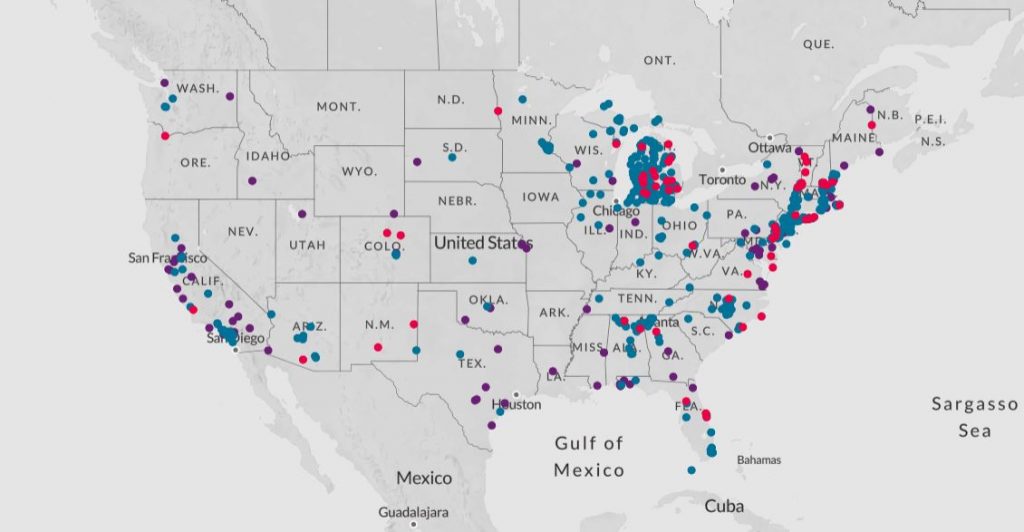PFAS Contamination: A National Water Crisis Affecting Millions

Table of Contents
The Sources of PFAS Contamination
PFAS contamination originates from a variety of sources, many stemming from industrial processes and consumer products. Understanding these sources is critical to mitigating the problem.
Industrial Sources
Major industrial contributors to PFAS pollution include:
- Teflon manufacturing: The production of Teflon and other fluoropolymers releases significant amounts of PFAS into the environment.
- Military bases: A primary source is the use of Aqueous Film-Forming Foam (AFFF) used in firefighting exercises at military installations. These foams contain high concentrations of PFAS. Examples like the contamination at numerous US military bases highlight the scale of this issue.
- Chrome plating plants: The electroplating process, particularly chrome plating, often involves PFAS-containing chemicals that can contaminate surrounding water sources.
- Other industrial applications: Other industries, such as electronics manufacturing and semiconductor production, also contribute to PFAS contamination through the use of PFAS-containing chemicals.
Consumer Products
Many everyday consumer products contain PFAS, contributing to environmental contamination through their disposal and the gradual leaching of these chemicals. These include:
- Non-stick cookware: The non-stick properties of Teflon cookware are due to the presence of PFAS.
- Food packaging: Some food packaging materials, particularly those designed to be grease-resistant or water-repellent, contain PFAS.
- Stain-resistant fabrics and carpets: Stain-resistant treatments on fabrics often incorporate PFAS, releasing these chemicals over time through washing and wear.
- Personal care products: Some personal care products, such as certain types of cosmetics and shampoos, may contain PFAS.
The gradual release of PFAS from these products into wastewater and landfills contributes significantly to PFAS contamination of water sources.
Agricultural Runoff
Agricultural practices also play a role in PFAS contamination:
- PFAS-containing fertilizers and pesticides: Some agricultural chemicals contain PFAS, which can leach into groundwater and surface water through runoff.
- Biosolids application: The use of biosolids (treated sewage sludge) as fertilizer can introduce PFAS into agricultural soil and subsequently into water sources.
Health Risks Associated with PFAS Exposure
Exposure to PFAS poses significant health risks, with extensive research linking it to various adverse health outcomes.
Cancer Risks
Studies have shown a correlation between PFAS exposure and an increased risk of several types of cancer, including:
- Kidney cancer: Several studies demonstrate a link between high PFAS levels and increased kidney cancer risk.
- Testicular cancer: PFAS exposure has been associated with a heightened risk of testicular cancer.
- Liver cancer: Some research suggests a potential link between PFAS and liver cancer.
The specific PFAS compounds and the level of exposure influence the risk. Further research is ongoing to fully understand the carcinogenic potential of various PFAS.
Immune System Dysfunction
PFAS exposure significantly impacts the immune system, making individuals more vulnerable to infections and illnesses:
- Reduced antibody response: Studies indicate that PFAS can reduce the effectiveness of antibodies, weakening the body's ability to fight off infections.
- Increased susceptibility to infections: Lowered immune function resulting from PFAS exposure can make people more susceptible to various infections.
- Impaired vaccine response: Exposure to PFAS may reduce the effectiveness of vaccines.
Other Health Effects
Beyond cancer and immune system dysfunction, PFAS exposure has been linked to other health problems, including:
- Liver damage: PFAS can cause liver damage and dysfunction.
- Thyroid disorders: Some studies suggest a correlation between PFAS exposure and thyroid problems.
- Developmental issues in children: Exposure to PFAS during pregnancy and childhood has been linked to developmental delays and other adverse effects. The long-term health effects of PFAS exposure remain an area of ongoing research and investigation.
Addressing the PFAS Contamination Crisis
Tackling the PFAS contamination crisis requires a multi-pronged approach involving advanced water treatment, stringent regulations, and enhanced public awareness.
Water Treatment Solutions
Several technologies can effectively remove PFAS from drinking water:
- Granular activated carbon (GAC): GAC adsorption is a widely used method for PFAS removal.
- Ion exchange: Ion exchange resins can effectively capture PFAS ions from water.
- Foam fractionation: This technique separates PFAS from water using foam formation.
The effectiveness of these methods varies depending on the specific PFAS compounds present and the concentration levels.
Prevention and Regulatory Measures
Government regulations and industry initiatives are crucial in preventing further PFAS pollution and remediating existing contamination:
- EPA regulations: The EPA is actively working on establishing stricter regulations for PFAS in drinking water.
- Phase-out of PFAS in products: Efforts are underway to phase out PFAS in certain consumer products and industrial applications.
- Superfund sites: The Superfund program is addressing the cleanup of heavily contaminated sites.
Public Awareness and Advocacy
Raising public awareness and encouraging advocacy efforts are essential in addressing the PFAS contamination crisis:
- Stay informed: Learn about PFAS contamination in your community and the potential health risks.
- Support initiatives: Support organizations working to address PFAS contamination and promote safer water sources.
- Reduce your exposure: Be mindful of potential sources of PFAS exposure in your home and daily life.
Conclusion
The widespread PFAS contamination of our nation's water poses a serious threat to public health. The numerous sources of PFAS, the range of associated health risks, and the challenges in remediation highlight the urgency of this crisis. Addressing this requires a concerted effort involving advanced water treatment technologies, stricter regulations, and increased public awareness. Don't let PFAS contamination threaten your community's health. Learn more about PFAS testing in your area, contact your representatives to advocate for stronger regulations, and demand safer water sources for all. Together, we can combat PFAS contamination and protect our communities from its devastating effects.

Featured Posts
-
 Nba Playoffs 76ers Vs Celtics Prediction And Preview
May 15, 2025
Nba Playoffs 76ers Vs Celtics Prediction And Preview
May 15, 2025 -
 Todays Mlb Game Padres Vs Pirates Predictions And Betting Odds
May 15, 2025
Todays Mlb Game Padres Vs Pirates Predictions And Betting Odds
May 15, 2025 -
 Androids Updated Design Language Key Features And Changes
May 15, 2025
Androids Updated Design Language Key Features And Changes
May 15, 2025 -
 Record Breaking Prices For Kid Cudis Personal Items At Auction
May 15, 2025
Record Breaking Prices For Kid Cudis Personal Items At Auction
May 15, 2025 -
 Alex Ovechkin 894 Goals And A Historic Tie With Wayne Gretzky
May 15, 2025
Alex Ovechkin 894 Goals And A Historic Tie With Wayne Gretzky
May 15, 2025
Latest Posts
-
 12
May 16, 2025
12
May 16, 2025 -
 7 12
May 16, 2025
7 12
May 16, 2025 -
 Tom Cruise And Tom Hanks The Story Behind The Unpaid One Dollar Debt
May 16, 2025
Tom Cruise And Tom Hanks The Story Behind The Unpaid One Dollar Debt
May 16, 2025 -
 The Unpaid Dollar Tom Cruise And Tom Hankss Unsettled Debt
May 16, 2025
The Unpaid Dollar Tom Cruise And Tom Hankss Unsettled Debt
May 16, 2025 -
 Tom Cruise Still Owes Tom Hanks A Dollar Will He Pay Up
May 16, 2025
Tom Cruise Still Owes Tom Hanks A Dollar Will He Pay Up
May 16, 2025
